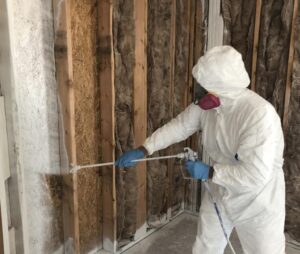It’s silent, sneaky and sometimes a little smelly.
(For the record, I don’t think ninjas are smelly but I can’t confirm or deny this because I’ve never actually met one… just as they prefer.)
If you notice a musty odor in certain areas of your home or see some discoloration in your walls, there’s a good chance you have your own little set of mold colonies growing, and that’s the pet nobody wants.
But before you declare a family meeting and decide to sell your house, have a mold inspection done.
There are many types of mold that can grow in homes, but they’re not all toxic and dangerous black mold. Unfortunately, you can’t determine this on your own, and some specific testing has to be done.
Air Testing During a Mold Inspection
There are a few ways mold inspectors can test for the present of mold in your home.
The most common form of testing is Air Testing, or Air Sampling as it’s sometimes called.
One of the first steps during a mold inspection is to test the air for any spores that might be floating around in the air and eventually making their way to your respiratory system.
If you call us, one of the certified members from our mold inspection team will take samples of both the air inside and outside your house.
“But I’m not worried about the mold outside!” you’re screaming.
It’s ok. We’re not just testing random areas of air for the heck of it. This is so we can gather information about the mold spores that would naturally exist in the outdoors and comparing it to the mold spores we find in your house.
This lets us know what next steps to take.
Once we have the air samples, we’ll send them off to a laboratory where scientists will confirm exactly what type of mold spores are present.
Which leads me to my next point…
Mold Types: Do I Need to Panic?
There’s a great deal of information out there that would lead you to believe that if you find mold in your house, your days are numbered if you don’t move immediately.
While toxic black mold (Stachybotrys chartarum) is very dangerous and should be treated by professionals as soon as you suspect you might have it, there are many different types of mold that like to grow in our houses.
In fact, a lot of them are black which leads people to panic over the mold they find on their shower curtain and think the whole time they’ve been soaping up, black mold has been seeping into their system.
Turns out, most of the time, the black mold on your shower curtain isn’t toxic.
The rest of the mold in your house can also be other types of mold than the big, bad, black mold. These too can cause some mild health problems (itchy eyes, rashes, and headaches to name a few) and certainly aren’t pleasant, but you can take your time to get together a plan of attack on how you’re going to address the issue.
This is where we come in…
Mold Solutions for All Your Mold Inspection Needs
Not to brag, but we know a thing or two about mold.
All of our team members are certified and knowledgeable about mold and are great resources if you suspect you may have a mold issue. We offer mold inspection along with individualized remediation plans because we understand that every home and situation is different.
If you’re considering a mold inspection for your home, give us a call today. We’d love to help!
Photo by Lasaye Hommes on Unsplash








